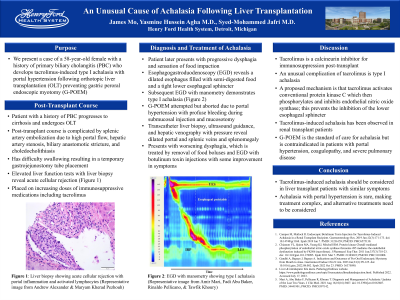Sunday Poster Session
Category: Esophagus
P0483 - An Unusual Cause of Achalasia Following Liver Transplantation
Sunday, October 22, 2023
3:30 PM - 7:00 PM PT
Location: Exhibit Hall

Has Audio
- JM
James Mo, BA
Wayne State University School of Medicine
Detroit, MI
Presenting Author(s)
James Mo, BA1, Yasmine Hussein Agha, MD2, Syed-Mohammed Jafri, MD2
1Wayne State University School of Medicine, Detroit, MI; 2Henry Ford Health System, Detroit, MI
Introduction: We present a case of a 58-year-old female with a history of primary biliary cholangitis (PBC) who develops tacrolimus-induced type I achalasia with portal hypertension following orthotopic liver transplantation (OLT) preventing gastric peroral endoscopic myotomy (G-POEM).
Case Description/Methods: A 58-year-old female with a history of PBC progresses to cirrhosis and undergoes OLT. Her post-transplant course is complicated by splenic artery embolization due to high portal flow, hepatic artery stenosis, biliary anastomotic stricture, and choledocholithiasis managed with endoscopic retrograde cholangiopancreatography. She has difficulty swallowing resulting in a temporary gastrojejunostomy tube placement. Elevated liver function tests with liver biopsy reveal acute cellular rejection. The patient is placed on increasing doses of immunosuppressive medications, tacrolimus, mycophenolate mofetil, and prednisone. She later presents with progressive dysphagia and sensation of food impaction. An esophagogastroduodenoscopy (EGD) reveals a significantly dilated esophagus filled with semi-digested food and a tight lower esophageal sphincter suspicious for achalasia. A subsequent EGD with manometry demonstrates type I achalasia. G-POEM is attempted but aborted due to portal hypertension with profuse bleeding during submucosal injection and mucosotomy. Transcatheter liver biopsy, ultrasound guidance, and hepatic venography with pressure reveal dilated portal and splenic veins and splenomegaly. This is managed through surgical splenectomy. She presents with worsening dysphagia, which is treated by removal of food boluses and EGD with botulinum toxin injections with some improvement in symptoms.
Discussion: Tacrolimus is a calcineurin inhibitor for immunosuppression post-transplant. However, an unusual complication of tacrolimus is type I achalasia. A proposed mechanism is that tacrolimus activates conventional protein kinase C which then phosphorylates and inhibits endothelial nitric oxide synthase. This prevents the inhibition of the lower esophageal sphincter. Tacrolimus-induced achalasia has been observed in renal transplant patients and should be considered in liver transplant patients with similar symptoms. G-POEM is the standard of care for achalasia but is contraindicated in patients with portal hypertension, coagulopathy, and severe pulmonary disease. Achalasia with portal hypertension is rare, making treatment complex. Alternative treatments include endoscopic botulinum toxin injections.
Disclosures:
James Mo, BA1, Yasmine Hussein Agha, MD2, Syed-Mohammed Jafri, MD2. P0483 - An Unusual Cause of Achalasia Following Liver Transplantation, ACG 2023 Annual Scientific Meeting Abstracts. Vancouver, BC, Canada: American College of Gastroenterology.
1Wayne State University School of Medicine, Detroit, MI; 2Henry Ford Health System, Detroit, MI
Introduction: We present a case of a 58-year-old female with a history of primary biliary cholangitis (PBC) who develops tacrolimus-induced type I achalasia with portal hypertension following orthotopic liver transplantation (OLT) preventing gastric peroral endoscopic myotomy (G-POEM).
Case Description/Methods: A 58-year-old female with a history of PBC progresses to cirrhosis and undergoes OLT. Her post-transplant course is complicated by splenic artery embolization due to high portal flow, hepatic artery stenosis, biliary anastomotic stricture, and choledocholithiasis managed with endoscopic retrograde cholangiopancreatography. She has difficulty swallowing resulting in a temporary gastrojejunostomy tube placement. Elevated liver function tests with liver biopsy reveal acute cellular rejection. The patient is placed on increasing doses of immunosuppressive medications, tacrolimus, mycophenolate mofetil, and prednisone. She later presents with progressive dysphagia and sensation of food impaction. An esophagogastroduodenoscopy (EGD) reveals a significantly dilated esophagus filled with semi-digested food and a tight lower esophageal sphincter suspicious for achalasia. A subsequent EGD with manometry demonstrates type I achalasia. G-POEM is attempted but aborted due to portal hypertension with profuse bleeding during submucosal injection and mucosotomy. Transcatheter liver biopsy, ultrasound guidance, and hepatic venography with pressure reveal dilated portal and splenic veins and splenomegaly. This is managed through surgical splenectomy. She presents with worsening dysphagia, which is treated by removal of food boluses and EGD with botulinum toxin injections with some improvement in symptoms.
Discussion: Tacrolimus is a calcineurin inhibitor for immunosuppression post-transplant. However, an unusual complication of tacrolimus is type I achalasia. A proposed mechanism is that tacrolimus activates conventional protein kinase C which then phosphorylates and inhibits endothelial nitric oxide synthase. This prevents the inhibition of the lower esophageal sphincter. Tacrolimus-induced achalasia has been observed in renal transplant patients and should be considered in liver transplant patients with similar symptoms. G-POEM is the standard of care for achalasia but is contraindicated in patients with portal hypertension, coagulopathy, and severe pulmonary disease. Achalasia with portal hypertension is rare, making treatment complex. Alternative treatments include endoscopic botulinum toxin injections.
Disclosures:
James Mo indicated no relevant financial relationships.
Yasmine Hussein Agha indicated no relevant financial relationships.
Syed-Mohammed Jafri: Gilead, Takeda, Abbvie – Advisor or Review Panel Member, Speakers Bureau.
James Mo, BA1, Yasmine Hussein Agha, MD2, Syed-Mohammed Jafri, MD2. P0483 - An Unusual Cause of Achalasia Following Liver Transplantation, ACG 2023 Annual Scientific Meeting Abstracts. Vancouver, BC, Canada: American College of Gastroenterology.
